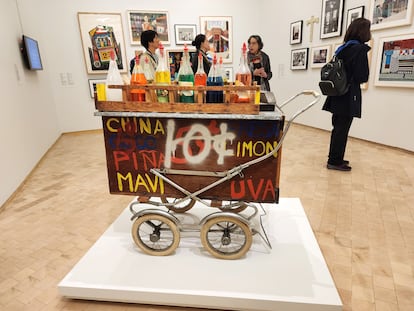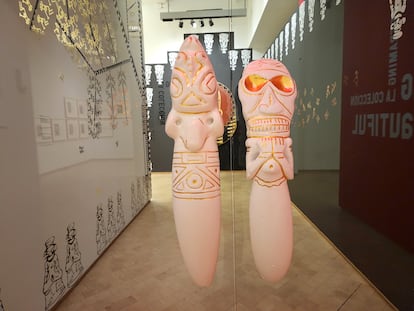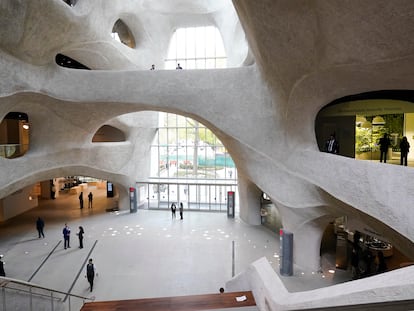New York’s ‘El Museo del Barrio’ reinvents itself with new permanent collection
The largest Latino museum in the U.S. is displaying 500 artworks, including more than 100 acquisitions and commissions obtained since 2000. Its commitment to diversity goes against the dominant narrative


If there is a museum in New York that is a breeding ground for concepts, proposals and political demands, it is none other than the Museo del Barrio (‘The Neighborhood Museum’) known by its Spanish name despite its location in Manhattan, north of the so-called Museum Mile. El Museo del Barrio, whose origins are entwined with the city’s Puerto Rican diaspora and their dual capacity as citizens and immigrants, is picking up momentum after the Covid pandemic with the most ambitious presentation of its permanent collection in more than two decades: an exhibition called Something Beautiful: Reframing La Colección.
Having already been closed for a year before the virus struck in 2020, the museum’s activity and outreach were severely hampered by the pandemic. Now, for the first time at a museum of its kind — it is the largest Latino museum in the U.S. — 500 works of art, including more than 100 new acquisitions and artists’ commissions since 2000, are being presented through rotating exhibitions over the course of a year. Divided into eight thematic sections and seven artist presentations, Something Beautiful emphasizes indigenous and non-indigenous artists, women and the nearly endless diversity of the Latino experience. As Patrick Charpenel, the museum’s director, recalled during a tour of the museum last Thursday, the Museo del Barrio is more than a museum or an art gallery: It has a strong political, militant and activist dimension.
From centuries-old Taino ritual vessels and and other tools attributed to the Siboney group, to highly topical expressions of queerness, the Museo del Barrio is a like journey through the sunlit mangrove roots — as visible as they are strong — of generations of Latino creators (Latinxs, to use the museum’s inclusive spelling and naming conventions). Since 1971, when it received its first major donation, a portfolio of works by Puerto Rican social artists called La estampa puertorriqueña (The Puerto Rican Print), engravings and the social character of the museum have marked its development, and today engravings are a central part of the permanent collection.
There are classic works by artists such as Rafael Tufiño, born in Brooklyn but returned to San Juan at age 10. During his lifetime he was known as the people’s painter, and his precious portrait of a Lavandera (washerwoman) is on display in the museum. He died in Puerto Rico in 2008. The contemporary artist David Antonio Cruz, author of an expressive Puerto Rican Pietà also has pieces in the permanent collection, which includes prints, textile samples, kinetic or movement art. There are photographs too, such as the sensual and surreal Photopoems and Acting as Behavior series by the well-known artist Papo Colo, who devised the concept of “zero identity” to free himself from the burden of specificity, ethnicity and culture, and also to redefine his own masculinity.
El Museo del Barrio does not offer a cheerful and friendly, in other words, an easy visit, like those of nearby museums. “This collection does not fit into the canon of what museums in New York and throughout the U.S. traditionally collect and present,” explains the Mexican-born Charpenel, “and that’s why we want to try to tell a story that hasn’t been told. And it is very serious that until now [we] are not giving it visibility because the cultural history of the United States has been very poorly told, from a Eurocentric, Western canon. But the U.S. is a very diverse country. In fact, few people know it but Queens [one of New York City’s boroughs] is the most culturally diverse area in the world.” Among other characteristic features of Queens are the usual celebration of Santa Muerte and the never-ending supply of Latin food.
For this reason, El Museo del Barrio wants to be “one of those institutions that talks about diversity, because we are the most representative and most important Latinx collection in the U.S.,” Charpenel emphasizes. “And we want to open a series of conversations about art, diversity, and cultural representation in the U.S.,” he adds, summarizing one of the objectives of this exhibition.

Charpenel is aware that the Museo del Barrio appeals to a different public than those who usually visit the Museum Mile, and that perhaps explains its relatively low attendance, “but we would like it to reach everyone, that’s why I talk a lot about opening a conversation ... with other museums, with academics; a conversation that highlights the importance of diversity, of a cultural production that has been here for many centuries, but that has not been included in the narratives, in the canon of what is supposedly American art.”
Nor, because of its specificity, does the museum wish to limit itself to the Latino community as the only potential, or majority, audience. During the pandemic closure, the director recalls, “we undertook the action of not only increasing the collection at a significant rate — several of the best pieces in the collection are recent additions — but more importantly, we undertook a research project to question the way in which the collection had been historically restructured in previous years, to connect it more to its roots, its neighborhood, its political and activist roots, its cultural roots. Our purpose was to bring it much closer to what it is, to the identity of a community that has been historically marginalized, excluded from the great cultural institutions of the United States.”
On a previous visit to the Museo del Barrio, still closed due to the pandemic, an impressive series of photographs from the U.S.-Mexico border occupied a prominent place in one of the galleries, in front of the work of other artists who explored femicide as a motif of inspiration and condemnation. Charpenel assumes that the museum is also a document of current affairs, open “to exclusion, marginalization, which are our natural themes ..., queerness, everything that has to do with diversifying the U.S. cultural experience, that is, with all those things that have been historically made invisible. The purpose of this institution is to decolonize these dominant narratives.”
Suketu Mehta, the writer who grew up in the the very neighborhood to which Charpenel alludes, maintained in an interview that the great fear of Trumpism is that the United States will cease to be a white country within a generation, and also that it will stop speaking English, as if Spanish were not already an indisputable and almost hegemonic reality. Hand in hand with language, including Spanglish, the cultures of Latin America are making advances in forging the great American culture.
Sign up for our weekly newsletter to get more English-language news coverage from EL PAÍS USA Edition
Tu suscripción se está usando en otro dispositivo
¿Quieres añadir otro usuario a tu suscripción?
Si continúas leyendo en este dispositivo, no se podrá leer en el otro.
FlechaTu suscripción se está usando en otro dispositivo y solo puedes acceder a EL PAÍS desde un dispositivo a la vez.
Si quieres compartir tu cuenta, cambia tu suscripción a la modalidad Premium, así podrás añadir otro usuario. Cada uno accederá con su propia cuenta de email, lo que os permitirá personalizar vuestra experiencia en EL PAÍS.
¿Tienes una suscripción de empresa? Accede aquí para contratar más cuentas.
En el caso de no saber quién está usando tu cuenta, te recomendamos cambiar tu contraseña aquí.
Si decides continuar compartiendo tu cuenta, este mensaje se mostrará en tu dispositivo y en el de la otra persona que está usando tu cuenta de forma indefinida, afectando a tu experiencia de lectura. Puedes consultar aquí los términos y condiciones de la suscripción digital.
More information
Últimas noticias
Most viewed
- Reinhard Genzel, Nobel laureate in physics: ‘One-minute videos will never give you the truth’
- Oona Chaplin: ‘I told James Cameron that I was living in a treehouse and starting a permaculture project with a friend’
- Pablo Escobar’s hippos: A serious environmental problem, 40 years on
- Charles Dubouloz, mountaineering star, retires at 36 with a farewell tour inspired by Walter Bonatti
- Why we lost the habit of sleeping in two segments and how that changed our sense of time










































